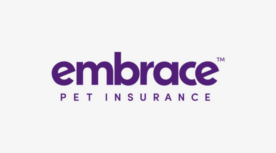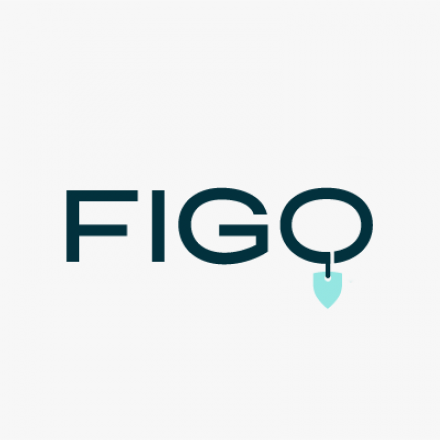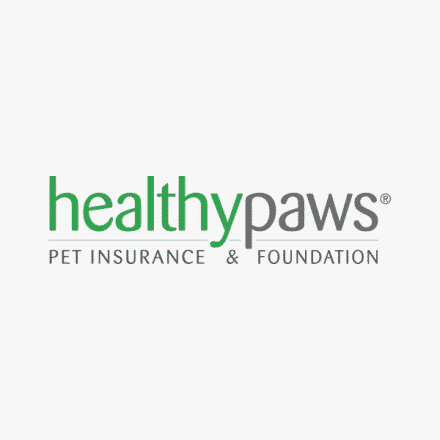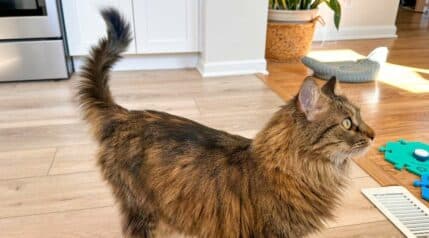When you purchase through links on our site, we may earn a commission. Here’s how it works.
Pet insurance can be confusing, but we’re here to break it down. About 45.3 million households own cats in the U.S., which means you’re not alone in your hunt for the best pet insurance for cats. All pet insurance providers offer coverage for health conditions, but not all are the same. Each company differs in coverage, price, waiting periods, customer service, and more. We’ll simplify pet insurance for you, so you feel empowered to make the best decision for your cat and your family.
Pet insurance is similar to health insurance for humans, except it’s for our furry companions. One of the biggest differences is that most policies and companies require you to pay for the medical expenses for your cat upfront and then submit a claim and wait for reimbursement of applicable items. However, some companies offer direct payment to your vet, eliminating the reimbursement process altogether.
Our pet insurance guide gives you an overview of the best pet insurance companies and what you should consider when choosing a policy. We explain each company’s strengths and weaknesses, when pet insurance is worth it, how to adjust the cost to fit into your budget, and more.
Best Pet Insurance For Cats At A Glance

Best
Overall

Best For
Older Pets

Best For
Wellness Coverage
Pet Insurance 101
According to NAPHIA (North American Pet Health Insurance Association), dogs make up the majority of insured pets, holding 81.7% of policies for dogs, while cats constitute the other 18.3%. However, cats have seen a higher growth rate in policies than dogs in recent years, signaling that cat parents are starting to understand the benefit of finding the best care for their felines and keeping their wallets protected. Meanwhile, the majority of U.S. households can’t afford an emergency exceeding $1,000, making pet insurance an affordable way to budget for unexpected costs.
How Is Pet Insurance Cost Calculated?
Companies use several factors to determine the policy price.
- Species – Cats are typically more affordable to insure than dogs. This is because the larger size of most dogs requires higher doses of medication, bigger medical equipment, etc. Additionally, dog owners tend to submit more claims than cat parents.
- Breed – Certain breeds are predisposed to genetic health conditions, increasing policy costs.
- Location – Veterinary care tends to be less expensive in rural areas and more expensive in metropolitan areas. There are also different regulations, taxes, and other costs that can increase medical prices from one location to another. Because of this, the pet insurance providers can vary pricing to help offset these varying location-based expenses.
- Age – Generally speaking, the younger your pet is upon enrollment, the lower your premium will be. As pets age, they’re more likely to experience a health crisis or injury and are also more prone to age-related health conditions, increasing the premium.
- Gender – More claims are submitted for male pets, so premiums tend to be lower for females.
Deductible, Reimbursement, And Payout Options

You can modify your premium to align with your budget by adjusting the deductible, reimbursement percentage, and payout option. However, altering these will also change the amount of money you’re responsible for paying should you file a claim for your cat. Let’s dive in to learn more about this confusing insurance jargon.
What Is The Deductible?
This is the portion of the vet bill you’re responsible for before your provider starts considering reimbursement. The higher your deductible, the lower your premium tends to be.
There are two types of deductibles: annual and incident. Annual deductibles are paid once during the year policy period, while per-incident deductibles are paid for each new emergency your pet experiences.
Annual deductibles are easier to budget for than per-incident deductibles because you know you’ll only have to pay the deductible once during your annual policy period. With per-incident deductibles, you can’t predict how often your cat will visit the vet, so you can’t set an expectation of what you’ll need to be prepared to pay. However, once a per-incident deductible is paid for a condition, it won’t need to be paid for again during the pet’s lifetime (so long as you maintain continuous coverage through your pet insurance provider). For example, a per-incident deductible could prove advantageous for a cat that is diagnosed with a chronic condition like allergies during their policy’s eligibility window and requires lifetime treatment.
Nearly all pet insurance companies have annual deductibles. The only major pet insurance provider that has a per-incident deductible is Trupanion.
What Is The Reimbursement Percentage?
This is the amount covered by the pet insurance provider either before or after the deductible (depending on the company’s reimbursement method). The leftover portion after the reimbursement is known as your copay, which you’re responsible for paying for each claim.
For example, if you choose a 90% reimbursement level, then your copay is 10%. Most companies allow you to choose your reimbursement. However, some have set amounts that cannot be altered (i.e., Trupanion has only one reimbursement option, and it is 90%).
What Are Payout Options?
This is the highest reimbursement amount a pet insurance company will pay during the policy period or over your pet’s lifetime. A low payout amount translates to you having more responsible for costs if your pet’s vet treatment exceeds the selected amount but often allows for lower premium prices.
Most companies have annual payout options. An exception is Trupanion, which has a lifetime payout term. However, because Trupanion’s payout is unlimited, this isn’t concerning.
The majority of companies offer multiple payout options. On average, the higher the payout option you select, the higher your premium. However, this isn’t always the case, and sometimes companies offer more affordable premiums for unlimited payouts than another company quoting a lower payout option. This is one of the countless reasons to get at least three quotes from different companies and read the fine print before signing up for any insurance policy.
What Are The Types Of Plans?
There are two different types of pet insurance plans to choose from. Choosing the type of coverage you want will determine which policy you select.
- Accident-Only – These plans cover injuries, including foreign body ingestion, poisoning, broken bones, and other urgent health concerns. Accident-only plans are typically more affordable than accident and illness plans, and they can be a nice option for pets with pre-existing conditions that may have certain illness items excluded from coverage.
- Accident & Illness – These policies are the most extensive because they cover items listed in the accident-only plan as well as illnesses, such as stomach issues, urinary tract infections, cancer, heart conditions, and more.
Some companies also offer a wellness plan (aka preventative care plan) during the enrollment process. This commonly covers routine vet expenses (i.e., annual exams, spay/neuter procedures, vaccinations, etc.) but varies by provider. It’s typically available as an add-on to an accident-only or accident and illness policy, but some companies allow you to purchase it without an insurance policy. This add-on coverage isn’t technically an insurance product.
Which Company Offers The Best Pet Insurance For Cats?
We chose these companies based on their performance and reputations when it comes to comprehensive coverage, customization options, pricing, customer service and reputation, and claim processing.
Best Overall
Pets Best

- Extensive coverage
- Some of the lowest prices
- No age limits or restrictions
- Detailed dental coverage
Pets Best is the best pet insurance for cats because it offers extensive coverage at some of the lowest average prices in the industry. There are few age limits or restrictions, and it provides detailed dental coverage. You can begin covering your kitty as young as seven weeks old, and it offers accident-only, accident and illness, and wellness plan add-ons.
Plan Options
- Annual Payouts: $5,000 or unlimited
- Annual Deductibles: $50, $100, $200, $250, $500, or $1,000
- Reimbursements: 70%, 80%, or 90%
Pros & Cons Comparison Table
| Pros | Cons |
|---|---|
| Consistently among the lowest prices without sacrificing coverage | Claim processing is among the longest |
| No upper age limits | Excludes bilateral conditions and alternative/holistic therapies |
| Covers curable pre-existing conditions once healed or cured | $2 transaction fee (waived if you pay annually or live in MD or AK) |
| 5% off for multiple pets and military members | |
| Optional wellness plans (not insurance) |
Best For Older Cats
Figo

- No age limits or restrictions
- Diminishing deductible for healthy pets
- Offers 100% reimbursement
- Fast claim processing
Figo is the best pet insurance for older cats because there are no upper age limits or restrictions, so that you can sign your cat up at any age. It also has a unique diminishing deductible, which decreases by $50 for each claim-free year until it’s down to $0. This can help reduce the cost of your cat’s insurance policy over the long term.
Plan Options
- Annual Payouts: $5,000, $10,000, or unlimited
- Annual Deductibles: $100, $250, $500, or $750
- Reimbursements: 70%, 80%, 90%, or 100%
Pros & Cons Comparison Table
| Pros | Cons |
|---|---|
| One of the only companies to offer 100% reimbursement | $15 administration fee and $2 transaction fee (waived if you pay annually) |
| No upper age limits | |
| Covers curable pre-existing conditions that are symptom-free for 1 year | |
| Claim processing averages 3 days | |
| Diminishing deductible | |
| 5% off for multiple pets | |
| Optional wellness plans (not insurance) |
Best Wellness Coverage Offered By An Insurance Provider
Embrace

- Three optional wellness plans
- Diminishing deductible for healthy pets
- Covers exam fees
- Some curable pre-existing conditions are eligible for coverage
Embrace offers three optional wellness plans depending on how much preventative care coverage you want ($250, $450, or $650). It reimburses 100% of your cat’s routine costs up to your selected coverage. The money can go toward wellness visits, vaccinations, spay/neuter surgery, routine blood tests, teeth cleaning, and other preventative care items. Similar to Figo, Embrace also offers a Healthy Pet Deductible, which decreases by $50 for each claim-free year until it drops to $0.
Plan Options
- Annual Payouts: $5,000, $8,000, $10,000, $15,000, $30,000, or unlimited available via telephone
- Annual Deductibles: $200, $300, $500, $750, or $1,000
- Reimbursements: 70%, 80%, or 90%
Pros & Cons Comparison Table
| Pros | Cons |
|---|---|
| Covers curable pre-existing conditions that are symptom-free for 1 year | $25 enrollment fee and $1 transaction fee (waived if you pay annually) |
| Healthy Pet Deductible | Maximum enrollment age is 14 |
| Claim processing averages 5 days | |
| Accident-only plan is available for pets 15 and older | |
| Up to 10% off for multiple pets | |
| Optional wellness plans |
Healthy Paws
Healthy Paws has one of the fastest claim processes in the industry, averaging two days. Customer reviews show that the majority are happy with their purchase and coverage. Healthy Paws also offers some of the most affordable coverage for unlimited payouts.
Healthy Paws

- Unlimited payouts for all plans
- Among the fastest claim processing
- High customer satisfaction
- Affordable coverage for unlimited payouts
Plan Options
Healthy Paws has restrictions on reimbursement and annual deductible amounts based on your cat’s age.
- Annual Payouts: Unlimited only
- Annual Deductibles: $100, $250, $500, $750, or $1,000
- Reimbursements: 50%, 60%, 70%, 80%, or 90%
Pros & Cons Comparison Table
| Pros | Cons |
|---|---|
| High customer satisfaction | Age restrictions on reimbursement and deductible amounts |
| Claim processing averages 2 days | Doesn’t cover curable pre-existing conditions |
| Unlimited payout limits means even high-cost vet bills will be covered at your policy’s reimbursement and deductible levels | $25 one-time enrollment fee in some states |
| No discount for multiple pets | |
| Maximum enrollment age is 14 | |
| Not available in WA | |
Trupanion
Trupanion

- Per-incident deductible
- No transaction or one-time fees
- Can pay the vet directly through Trupanion Express
- 90% reimbursement and unlimited payouts for all plans
Trupanion is one of the only pet insurance companies with a per-incident deductible instead of an annual one. Depending on your cat’s health and susceptibility to accidents, this could help you save money or end up costing more because you must pay the deductible for each new emergency your pet encounters. On average, annual deductibles are less costly to policyholders than per-incident deductibles.
Plan Options
- Annual Payouts: Unlimited
- Annual Deductibles: $0-$1,000 ($5 increments)
- Reimbursements: 90%
Pros & Cons Comparison Table
| Pros | Cons |
|---|---|
| Covers curable pre-existing conditions if there are no signs or symptoms after the standard waiting periods | Fewer plan customization options with only unlimited payouts and 90% reimbursement |
| Trupanion Express allows Trupanion to pay the vet directly and avoid waiting for reimbursement | No discount for multiple pets |
| No transaction or one-time fees | Maximum enrollment age is 14 |
| Claim processing averages less than 5 days | |
Lemonade
Lemonade

- Artificial Intelligence (AI)-driven claims process allows claim processing within seconds
- Competitive pricing
- Ability to bundle with other insurance products
- No available in all 50 state
Lemonade is known for its unique Artificial Intelligence (AI)-driven claims process, which allows it to process claims within seconds of receipt of all required documentation. Founded in 2020, Lemonade is still new to the pet insurance industry, so it doesn’t have the long-standing reputation other companies have, nor is it available in all 50 states. But its competitive pricing makes it worth getting a quote for your kitty if it’s an option in your area.
Plan Options
- Annual Payouts: $5,000, $10,000, $20,000, $50,000, or $100,000
- Annual Deductibles: $100, $250, or $500
- Reimbursements: 70%, 80%, or 90%
Pros & Cons Comparison Table
| Pros | Cons |
|---|---|
| AI-driven claims process is extremely fast | Not available in all 50 states |
| Can bundle with homeowners or renters insurance | Customer service is AI-driven, which can create frustration for some policyholders |
| Consistently among the least expensive | |
| Covers curable pre-existing conditions if they’re cured for 1 year | |
| Optional wellness plans (not insurance) |
Is Pet Insurance Worth It?
According to NAPHIA (North American Pet Health Insurance Association), the average monthly premium for an accident and illness insurance policy in the U.S. in 2022 was $32.25 for cats. You may think this is an unnecessary bill, but considering some cat emergencies can cost thousands of dollars, it could be beneficial for your family to maintain a budget. Not to mention you won’t be faced with choosing between your cat’s life and your bank balance during these difficult times.
Let’s say your cat experiences some stomach issues, which is one of the most popular claims submitted to pet insurance companies for felines. Depending on your cat’s symptoms, your vet may recommend several diagnostics to help determine the cause, and these tests can be expensive without pet insurance.
- X-Ray – $150 – $400
- Endoscopy – $800 – $1,000
- Biopsy – Up to $1,500
- Ultrasound – $300 – $500
- CT Scan – Up to $3,000
Depending on the diagnostic results, your vet may diagnose your cat with a gastrointestinal disorder, inflammation, food allergies, poisoning, intestinal bacteria, parasites, or something else. Once a diagnosis is made, you’ll most likely be facing more vet bills for the treatment of the condition.
If the diagnostic expenses above look worrisome for your budget, pet insurance can be an excellent financial management tool. Not to mention that vet costs typically don’t stop after diagnosis since you still have to treat the condition.
A Pet Insurance Reimbursement Example
Suppose the total vet bill for your cat’s tummy issues was $2,000, and the deductible for your pet insurance plan you selected is $500, with a 90% reimbursement level. This would mean that you’d expect the insurance company to pay $1,350 or $1,300, depending on their reimbursement method.
There are two methods of reimbursement commonly used.
- Deductible then Copay – This method takes the vet bill amount minus the remaining annual deductible minus the copay.
- $2,000 – $500 (deductible) – $150 (10% of $1,500) = $1,350 reimbursement and you’d pay $650
- Copay then Deductible – This method takes the vet bill amount minus the copay minus the remaining annual deductible.
- $2,000 – $200 (10% of $2,000) – $500 (deductible)= $1,300 reimbursement and you’d pay $700
With pet insurance, you’re only responsible for a small portion of the vet bill compared to the full amount. As you can see, the payment you’re responsible for is variable based on the reimbursement method. Not everyone chooses pet insurance. But if you do, it can help ease your mind knowing that you’ll have financial help in an emergency situation involving your loved one.
Final Thoughts
There’s a lot to consider before choosing a pet insurance company and finding the right policy for your cat. We hope you feel more prepared and comfortable making the right decision for your family by using the information we’ve given you. Each company discussed above offers extensive coverage, but their areas of expertise may differ.
Choosing the best pet insurance provider and policy isn’t a one-size-fits-all approach, and it’s important to consider all of the vital factors of your cat as well as read the fine print. That way, you know what’s covered and excluded in your policy. Don’t hesitate to call the company to help explain any vague insurance jargon or speak with your vet.




